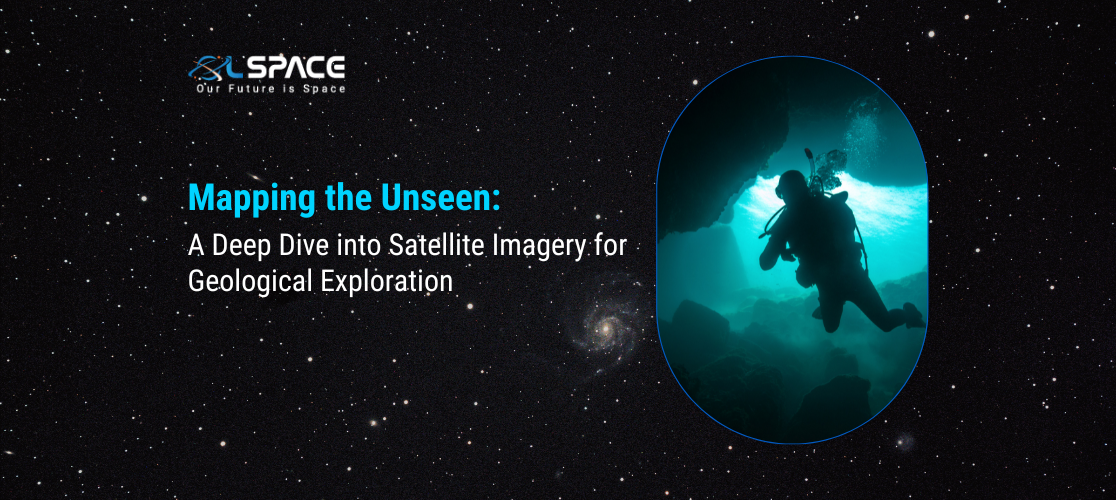21 November 2023
Mapping the Unseen: A Deep Dive into Satellite Imagery for Geological Exploration

Satellite imagery has become an indispensable tool for geological exploration, offering a bird’s-eye view of the Earth’s surface and unveiling details that may remain unseen from the ground. This technology has revolutionised the field of geology, enabling scientists, researchers, and exploration teams to map and analyse geological features with unprecedented precision. In this blog, we will take a deep dive into the use of satellite imagery for geological exploration and the insights it provides.
Advantages of Satellite Imagery in Geological Exploration
1. Global Coverage:
Satellites provide comprehensive coverage of the Earth’s surface, including remote and inaccessible areas. This global perspective is invaluable for geological exploration, allowing researchers to study diverse terrains and geological formations.
2. Multi-Spectral Imaging:
Satellites are equipped with sensors that capture data across multiple spectra, including visible, infrared, and thermal wavelengths. This multi-spectral imaging enables geologists to analyse various aspects of the Earth’s surface, such as rock types, vegetation, and surface temperature.
3. Change Detection:
Satellite imagery facilitates the detection of changes in the landscape over time. This is crucial for monitoring geological processes, identifying land cover changes, and assessing the impact of natural events such as earthquakes, landslides, or volcanic eruptions.
4. Terrain Analysis:
High-resolution satellite imagery allows for detailed terrain analysis. Geologists can study topographic features, evaluate slope gradients, and identify geological structures such as faults or folds. This information aids in understanding the geological history of an area.
5. Mineral Exploration:
Spectral analysis of satellite imagery helps identify mineral compositions in the Earth’s crust. Remote sensing techniques, such as hyperspectral imaging, enable the detection of specific mineral signatures, supporting mineral exploration and resource estimation.
6. Vegetation Analysis:
Healthy and stressed vegetation can be distinguished through satellite imagery. This information is valuable for ecological studies and can indirectly indicate underlying geological conditions, such as the presence of underground water sources.
7. Water Body Detection:
Satellites can identify and monitor water bodies, including rivers, lakes, and reservoirs. This is essential for understanding hydrological processes, studying sediment transport, and assessing the impact of water on geological formations.
Applications in Geological Exploration
1. Structural Geology:
Satellite imagery aids in structural geology by providing a broad view of geological features. Researchers can analyse fault patterns, fold structures, and other tectonic features, contributing to a better understanding of the Earth’s crustal dynamics.
2. Mineral Resource Mapping:
The identification and mapping of mineral resources are enhanced through satellite imagery. By analysing the reflectance patterns in different spectral bands, geologists can identify minerals associated with ore deposits, streamlining exploration efforts.
3. Oil and Gas Exploration:
Satellite data supports oil and gas exploration by assisting in the identification of potential hydrocarbon reservoirs. Subsurface structures and geological features that may indicate the presence of oil or gas can be analysed from space.
4. Environmental Impact Assessment:
Geological exploration often involves assessing the environmental impact of mining or exploration activities. Satellite imagery helps monitor changes in land use, vegetation cover, and water quality, facilitating environmental impact assessments.
5. Natural Hasard Monitoring:
Satellites contribute to the monitoring of natural hasards such as earthquakes, landslides, and volcanic eruptions. This real-time data is crucial for early warning systems and emergency response planning.
Challenges and Considerations
1. Cloud Cover:
Cloud cover can hinder the acquisition of clear satellite imagery. In regions with persistent cloud cover, obtaining consistent data may be challenging.
2. Spatial Resolution:
While high-resolution satellites offer detailed imagery, there are limitations in terms of spatial resolution. Fine-scale geological features may require specialised sensors or ground-based surveys.
3. Temporal Resolution:
Temporal resolution refers to how often a satellite revisits a specific location. Frequent revisits are essential for monitoring dynamic geological processes, and satellite constellations aim to address this need.
4. Data Interpretation:
Interpreting satellite imagery requires expertise in remote sensing and geological analysis. Collaborations between remote sensing specialists and geologists are essential for accurate data interpretation.
Future Trends and Innovations
Ongoing advancements in sensor technology, including higher spectral resolution and improved spatial resolution, will enhance the capabilities of satellite imagery for geological exploration.
1. Integration with Artificial Intelligence:
The integration of artificial intelligence (AI) and machine learning algorithms will streamline the analysis of vast amounts of satellite data. Automated feature recognition and classification can accelerate geological mapping.
2. mall Satellite Constellations:
Small satellite constellations, comprising numerous smaller satellites working together, are becoming more prevalent. These constellations enhance temporal resolution, allowing for more frequent monitoring of geological changes.
3. Hyperspectral Imaging:
Hyperspectral imaging captures a wide range of spectral bands, providing detailed information about the composition of geological materials. The continued development of hyperspectral sensors will refine mineral
Join our community and never miss an update! Subscribe to our newsletter and blog to stay up-to-date on the latest trends, tips, and insights in your area of interest. Don’t miss out on exclusive content, promotions, and special offers. Sign up now and be a part of our growing community!
